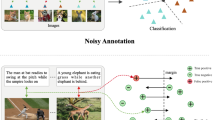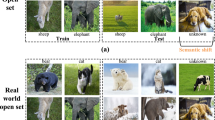Abstract
Hashing methods have received significant attention for effective and efficient large scale similarity search in computer vision and information retrieval community. However, most existing cross-view hashing methods mainly focus on either similarity preservation of data or cross-view correlation. In this paper, we propose a graph regularized supervised cross-view hashing (GSCH) to preserve both the semantic correlation and the intra-view and inter view similarity simultaneously. In particular, GSCH uses intra-view similarity to estimate inter-view similarity structure. We further propose a sequential learning approach to derive the hashing function for each view. Experimental results on benchmark datasets against state-of-the-art methods show the effectiveness of our proposed method.







Similar content being viewed by others
References
Blei DM, Ng AY, Jordan MI (2003) Latent dirichlet allocation. J Mach Learn Res 3:993–1022
Bronstein MM, Bronstein AM, Michel F, Paragios N (2010) Data fusion through cross-modality metric learning using similarity-sensitive hashing. In: CVPR, vol 1. San Francisco, p 5
Chen N, Zhu J, Sun F, Xing EP (2012) Large-margin predictive latent subspace learning for multiview data analysis. IEEE Trans Pattern Anal Mach Intell 34(12):2365–2378
Cui J, Liu Y, Xu Y, Zhao H, Zha H (2013) Tracking generic human motion via fusion of low-and high-dimensional approaches. IEEE Trans Syst Man Cybern Syst 43(4):996–1002
De Sa VR, Gallagher PW, Lewis JM, Malave VL (2010) Multi-view kernel construction. Mach Learn 79(1-2):47–71
Ding G, Guo Y, Zhou J (2014) Collective matrix factorization hashing for multimodal data. In: Proceedings of the IEEE conference on computer vision and pattern recognition, pp 2075–2082
Gionis A, Indyk P, Motwani R et al (1999) Similarity search in high dimensions via hashing. In: VLDB, vol 99, pp 518–529
Gong Y, Lazebnik S (2011) Iterative quantization: a procrustean approach to learning binary codes. In: IEEE Conference on computer vision and pattern recognition (CVPR), 2011. IEEE, pp 817–824
Hwang SJ, Grauman K (2012) Reading between the lines: object localization using implicit cues from image tags. IEEE Trans Pattern Anal Mach Intell 34(6):1145–1158
Kang WC, Li WJ, Zhou ZH (2016) Column sampling based discrete supervised hashing. In: AAAI, pp 1230–1236
Kulis B, Jain P, Grauman K (2009) Fast similarity search for learned metrics. IEEE Trans Pattern Anal Mach Intell 31(12):2143–2157
Kumar S, Udupa R (2011) Learning hash functions for cross-view similarity search. In: IJCAI Proceedings-international joint conference on artificial intelligence, vol 22, p 1360
Lin Z, Ding G, Hu M, Wang J (2015) Semantics-preserving hashing for cross-view retrieval. In: Proceedings of the IEEE conference on computer vision and pattern recognition, pp 3864–3872
Liu W, Wang J, Kumar S, Chang SF (2011) Hashing with graphs. In: Proceedings of the 28th international conference on machine learning (ICML-11), pp 1–8
Liu W, Wang J, Ji R, Jiang YG, Chang SF (2012) Supervised hashing with kernels. In: IEEE Conference on computer vision and pattern recognition (CVPR), 2012. IEEE, pp 2074–2081
Liu W, Mu C, Kumar S, Chang SF (2014) Discrete graph hashing. In: Advances in neural information processing systems, pp 3419–3427
Liu Y, Nie L, Han L, Zhang L, Rosenblum DS (2015) Action2activity: recognizing complex activities from sensor data. In: IJCAI, vol 2015, pp 1617–1623
Liu Y, Nie L, Liu L, Rosenblum DS (2016) From action to activity: sensor-based activity recognition. Neurocomputing 181:108–115
Liu Y, Zhang L, Nie L, Yan Y, Rosenblum DS (2016) Fortune teller: predicting your career path. In: AAAI, vol 2016, pp 201–207
Liu Y, Zheng Y, Liang Y, Liu S, Rosenblum DS (2016) Urban water quality prediction based on multi-task multi-view learning. In: IJCAI, vol 16, pp 2576–2582
Liu H, Ji R, Wu Y, Liu W, Hua G (2016) Supervised matrix factorization for cross-modality hashing. arXiv preprint arXiv:1603.05572
Liu L, Cheng L, Liu Y, Jia Y, Rosenblum DS (2016) Recognizing complex activities by a probabilistic interval-based model. In: AAAI, vol 30, pp 1266–1272
Liu L, Lin Z, Shao L, Shen F, Ding G, Han J (2017) Sequential discrete hashing for scalable cross-modality similarity retrieval. IEEE Trans Image Process 26(1):107–118. https://doi.org/10.1109/TIP.2016.2619262
Lowe DG (2004) Distinctive image features from scale-invariant keypoints. Int J Comput Vis 60(2):91–110
Lu Y, Wei Y, Liu L, Zhong J, Sun L, Liu Y (2017) Towards unsupervised physical activity recognition using smartphone accelerometers. Multimed Tools Appl 76(8):10,701–10,719
Peng Y, Lu BL (2017) Discriminative extreme learning machine with supervised sparsity preserving for image classification. Neurocomputing 261:242–252. https://doi.org/10.1016/j.neucom.2016.05.113, http://www.sciencedirect.com/science/article/pii/S0925231217301972 Advances in Extreme Learning Machines (ELM 2015)
Rasiwasia N, Costa Pereira J, Coviello E, Doyle G, Lanckriet GR, Levy R, Vasconcelos N (2010) A new approach to cross-modal multimedia retrieval. In: Proceedings of the 18th ACM international conference on multimedia. ACM, pp 251–260
Rastegari M, Choi J, Fakhraei S, Daumé H III, Davis LS (2013) Predictable dual-view hashing. In: ICML (3), pp 1328–1336
Sharma A, Kumar A, Daume H, Jacobs DW (2012) Generalized multiview analysis: a discriminative latent space. In: IEEE Conference on computer vision and pattern recognition (CVPR), 2012. IEEE, pp 2160–2167
Shen F, Shen C, Liu W, Tao Shen H (2015) Supervised discrete hashing. In: Proceedings of the IEEE conference on computer vision and pattern recognition, pp 37–45
Shen X, Sun QS, Yuan YH (2016) Semi-paired hashing for cross-view retrieval. Neurocomputing 213:14–23 . https://doi.org/10.1016/j.neucom.2016.01.121, http://www.sciencedirect.com/science/article/pii/S092523121630724X. Binary Representation Learning in Computer Vision
Song J, Yang Y, Yang Y, Huang Z, Shen HT (2013) Inter-media hashing for large-scale retrieval from heterogeneous data sources. In: Proceedings of the 2013 ACM SIGMOD international conference on management of data. ACM, pp 785–796
Torralba A, Fergus R, Freeman WT (2008) 80 million tiny images: a large data set for nonparametric object and scene recognition. IEEE Trans Pattern Anal Mach Intell 30(11):1958–1970
Torralba A, Fergus R, Weiss Y (2008) Small codes and large image databases for recognition. In: Computer vision and pattern recognition, 2008. CVPR 2008. IEEE, pp 1–8
Wang J, Kumar S, Chang SF (2010) Sequential projection learning for hashing with compact codes. In: Proceedings of the 27th international conference on machine learning (ICML-10), pp 1127–1134
Wang J, Kumar S, Chang SF (2012) Semi-supervised hashing for large-scale search. IEEE Trans Pattern Anal Mach Intell 34(12):2393–2406
Weiss Y, Torralba A, Fergus R (2009) Spectral hashing. In: Advances in neural information processing systems, pp 1753–1760
Wu C, Zhu J, Cai D, Chen C, Bu J (2013) Semi-supervised nonlinear hashing using bootstrap sequential projection learning. IEEE Trans Knowl Data Eng 25(6):1380–1393. https://doi.org/10.1109/TKDE.2012.76
Xu H, Wang J, Li Z, Zeng G, Li S, Yu N (2011) Complementary hashing for approximate nearest neighbor search. In: 2011 International conference on computer vision. IEEE, pp 1631–1638
Xu X, He L, Shimada A, Taniguchi RI, Lu H (2016) Learning unified binary codes for cross-modal retrieval via latent semantic hashing. Neurocomputing 213:191–203
Zhang D, Li WJ (2014) Large-scale supervised multimodal hashing with semantic correlation maximization. In: AAAI, vol 1, p 7
Zhou J, Ding G, Guo Y (2014) Latent semantic sparse hashing for cross-modal similarity search. In: Proceedings of the 37th international ACM SIGIR conference on Research & development in information retrieval. ACM, pp 415–424
Zhu X, Huang Z, Shen HT, Zhao X (2013) Linear cross-modal hashing for efficient multimedia search. In: Proceedings of the 21st ACM international conference on multimedia. ACM, pp 143–152
Acknowledgements
The authors would like to thank the anonymous referees for their constructive suggestions and comments. This work was supported by the National Natural Science Foundation of China (Grants No. 61602248), the Fundamental Research Funds for the Central Universities (Grants No.KYZ201549) and the Natural Science Foundation of Jiangsu Province(Grants No. BK20160741).
Author information
Authors and Affiliations
Corresponding author
Rights and permissions
About this article
Cite this article
Shu, X., Jiang, H. & Xu, H. Graph regularized supervised cross-view hashing. Multimed Tools Appl 77, 28207–28224 (2018). https://doi.org/10.1007/s11042-018-5988-3
Received:
Revised:
Accepted:
Published:
Issue Date:
DOI: https://doi.org/10.1007/s11042-018-5988-3




